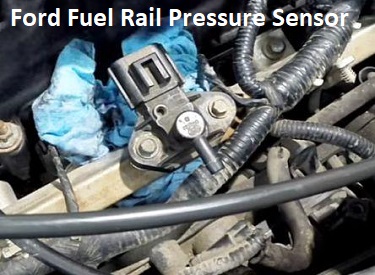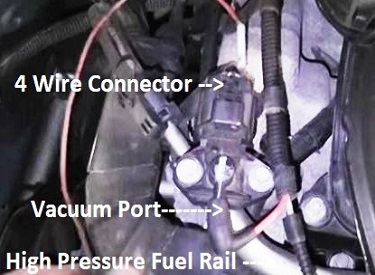Ford Fuel Pressure Sensor
When the Ford fuel pressure sensor fails some of the common symptoms include an engine that is hard starting or one with a severe lack of power.
Although these are the primary symptoms of the condition, failure of the fuel rail sensor will almost always set a diagnostic trouble code. The most popular codes set by a defective original equipment part remain the P0190 and the P0193.
These stand for fuel rail pressure sensor circuit malfunction and system circuit high output detected. In both cases the malfunction of the pressure sensor forces the computer to start guessing at the best fuel mixture.
The interesting thing about a Ford fuel pressure sensor is this relatively new design eliminates the old-style fuel pressure regulator and elimination of the entire fuel return system.
Quick Link: New Ford fuel pressure sensor for the most popular models.
Now they use this pressure sensor to send the computer real-time data so it can use this information to control the fuel pump operation on the fly.
We call the turning on and off of the fuel pump to achieve the correct pressure pulse width modulation. This system worked pretty well up until this point.
However, as these cars and trucks equipped with this type of system approach 10 years 100,000 miles we're starting to see an elevated failure rate of the component that reports pressure back to the computer.
 Ford Fuel Temperature and Pressure Sensor
Ford Fuel Temperature and Pressure SensorUnfortunately, the cost of this plastic part, brand-new from the dealership pushes well past $100. For this reason we need to verify that this component remains the true root cause of all of our problems.
Here we'll discuss how to make a few tests at the four wire connector before condemning the part. If you decide you want to replace the Ford fuel pressure sensor on your own, I have a few tips below to help the job go a little smoother.
Although the fuel rail sensor mounts in a convenient location, it's mounted in the fuel rail that’s holding back 65 psi of fuel pressure. Therefore, you must make sure you depressurize the system before you remove the retaining screws.
See the procedure below in the technical tips section. Finally, we'll cover a few common questions about the replacement parts. It's tempting to try one of those $14 made in China sensors.
However, unless you have a lot of time and patience I don't recommend this route. See an excellent compromise between a brand-new dealership branded part and the cheapest of the aftermarket choices in the parts section.
Diagnosing Injector Pressure Sensors
 Ford Fuel Rail Sensor Diagram
Ford Fuel Rail Sensor DiagramIn the Ford service manual they call this part an injector pressure sensor. However, the rest of the world is calling this the Ford fuel pressure sensor. This becomes important when you attempt to find replacement parts.
I'm a big believer in testing automotive electrical components before replacing them. Although the Ford fuel pressure sensor remains a weak spot with a high failure rate, other simple problems can cause the same P0193 diagnostic trouble code.
When you look at the sensor you'll see a red vacuum line connected to one side of the part. On the backside you'll see a four wire plug that we can perform some quick diagnosis on.
With the key on and the engine off we can either back probe or disconnect the connector and check for the 5V reference signal from the cars main computer. On the 2005 model year, you'll find the 5V reference signal at terminal 2. Identify the reference voltage wire by color.
They used a brown wire with a white tracer. This seems to apply across all of the popular models like the Ford Focus, the Taurus, Escape and Explorer sport-utility vehicles.
With that said, other years and other models could possibly use a different color wire. If you have the 5V reference signal at terminal 2 and you have a strong manifold vacuum signal at idle from the red vacuum line attaching to the pressure sensor, you probably have a bad part.
Although I have come across the check engine light code P0193 on a few different Ford vehicles, so far, the only thing I've found is a defective sensor. Another interesting point to make is this part seems reliable until it gets close to 100,000 miles.
Keep in mind this might be a coincidence on the vehicles that I've seen. Going forward, I will probably just go ahead and replace the component on vehicles that set the code and show more than 100,000 miles on the odometer. I’ll post an update here if I get burned and find another root cause.
Choosing Ford Fuel Sensor Parts
There's no question that we're starting to see an elevated failure rate of the Ford fuel pressure sensor on high mileage units. As the trend continues prices will come down. And we are already seeing this.
When you have an old ride it's only natural to try to spend less money on parts. However, my personal experience is not favorable with the ultra low priced replacement fuel injector sensors I've tried.
After having a few experiences with bad parts right out of the box, I started to use the Motorcraft parts over the aftermarket ones. Unfortunately, the little plastic sensor comes with a steep price tag when purchased through my local dealership.
Most plastic computer input sensors carry a price tag in the $50 range. With that said, this is a dual sensor that senses both fuel temperature and pressure at the same time. Nevertheless, the Ford dealership quoted a price just shy of $150 for parts.
In an effort to strike a compromise between the low quality replacements found on the Internet and the super expensive one found at the dealership, I tried the Bosch replacement part. Back in my day this company had a great name. Unfortunately, I hear they are not the same company they use to be.
With that said, so far I've had good luck. At less than half the price of the dealership offering this has worked out for me so far. If I do experience problems with the Bosch, Ford fuel pressure sensor I will come back here and amend this personal observation.
Replacing the Ford Fuel Pressure Sensor
 Ford Pressure Sensor Parts
Ford Pressure Sensor PartsOn first glances the Ford fuel pressure sensor looks like a walk in the park to replace. And it is, but we have one major concern to consider before we start removing the small bolts. This part measures fuel pressures greater than 60 psi.
In a nutshell, if you remove this component on a fully pressurized fuel rail, gas is going to spray all over the engine compartment. Imagine how bad this would be if the engine is at full operational temperature. Nevertheless, this potential for damage means that vigilance is required.
Before you remove the assembly you need to make sure to depressurize the rail. letting the automobile sit overnight becomes the easiest way to handle the situation. If you replace the part on a cold engine that hasn't run in the last 24 hours, there won't be any fuel pressure in the rail.
Unfortunately, we don't always have that luxury of waiting for the pressure to dissipate in the rail. In this situation we’ll have to run the automobile and then disconnect the fuel pump until the engine stalls. There is another possibility on some models and engine sizes.
On some models Ford installed test ports near the intake manifold so that technicians can take fuel pressure readings for diagnostic purposes. You can connect a fuel pressure test gauge to the Schrader valve fitting and use the bleed button on the tester to safely eliminate all fuel pressure in the system.
Always use hand tools around fuel system repairs, because electric and battery-operated tools make sparks that could ignite fuel vapor. Even when you remove all fuel pressure from the rail you should still stuff a few rags under the rail to absorb any fuel leakage during the replacement procedure.
Also be careful with the vacuum line when you pull it off of the port. These vacuum lines are getting very brittle on 10 year old cars with 100,000 miles.
I installed a Ford fuel pressure sensor on my friends Ford Focus. If you own one of these rides you might want to learn how a new engine mount fixes idle vibration on the Ford four-cylinder cars. For more information on what we cover here at fix my old ride visit the homepage.
Author bio : Mark is a retired ASE certified master technician, Chevrolet Professional Service Council member and the founder of FixMyOldRide.com. Watch the video on the about Mark the mechanic page to see his credentials. Mark hand writes all of the articles on FixMyOldRide.com unless indicated otherwise.